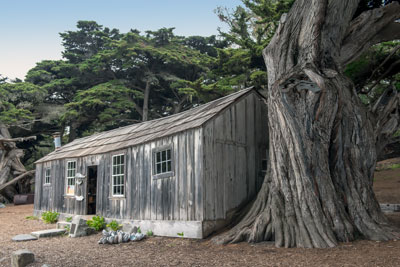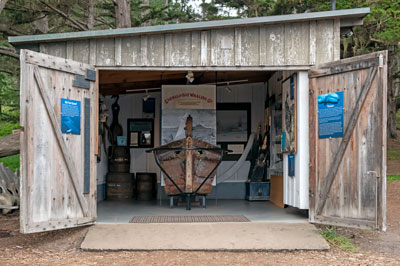National Register of Historic Places in Monterey County
Whaler's Cabin
Whaler's Cove
Point Lobos State Natural Reserve
Built c1850
The rocky shores of Point Lobos are a habitat for abalone, considered a delicacy by many cultures. Abalone shells are the source of mother-of-pearl which is used in furniture inlays, jewelry and buttons. The Ohlone tribe had gathered abalone here long before the Chinese arrived in 1851 and the Portuguese arrived in 1862.
Soon after the California gold rush of 1849, a small group of Chinese fishermen and their families set sail from southern China in thirty-foot junks. Following the prevailing winds and ocean currents, they probably arrived at Point Lobos around 1851 and established what may be the first Chinese fishing settlement in California. By 1853 several hundred Chinese were harvesting abalone commercially as well as squid, sea urchins and a variety of fish.
The Chinese settlement at Point Lobos consisted of about a dozen buildings, one of which remains and now houses the Whaler's Cabin Museum.
Portuguese whalers from the Azores arrived in 1862, some accompanied by their families, and settled in in communities of about fifty people to hunt the gray whales that migrate along the California coast from December to May. From the top of Whaler's Knoll, a lookout would spot passing whales and raise a flag to signal the crews down at the cove. The whalers rowed open-top boats out to sea to pursue the whales.
Harpooned whales were towed back to the cove and hoisted out of the water. Blubber was cut into small chunks and melted in large iron cauldrons called try pots to produce oil which was primarily used for lamps.
The invention of kerosene lamps in the late 1880s killed the Point Lobos whaling industry. A Japanese company revived whaling in 1887, but the operation lasted for only a few years.
The Whaling Station Museum at Whaler's Cove is the only on-site whaling museum on the west coast. It is one of sixteen shore whaling stations established on the California coast in the 19th century.
Source: Point Lobos Foundation website.


